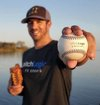Remotely Coaching Baseball Pitchers Using pitchLogic
As a pitching coach that works with more than 30 players, I don’t have enough time in the week to see every player on a regular schedule. Because of this, their independent practice between sessions is a crucial part of their training. I often use the quote, “The players that continue to put in work between our sessions are the ones that see the biggest growth.” This is 1,000% true. Also, I welcome parents (especially of the younger kids) to sit in on my lessons so they can learn and re-enforce what I am teaching. This is where pitchLogic comes in to play.
Younger Players
One of my younger players is an 8 year old that is just learning how to pitch. We have worked together for a few months now and dad has sat in on every lesson. Our main focal points have been back leg mechanics, posture, and arm action. Without going too in depth biomechanically, when he puts it all together, his arm slot is consistently in the 1:30-2:00 range. When he gets too much off of the toe or fails to utilize his scaps with his arm path, he drops well below 2:00.
After showing dad a few key things to look for, he felt confident that getting a pitchLogic baseball of his own would help the young player continue to develop. To say the least, this player has experienced tremendous growth. Dad will often send me screenshots of their pitchLogic data and he knows exactly what to look for when he and his son are training at home. The objective data of pitchLogic also makes father/son throwing sessions so much more meaningful.
College Players
I also work with a handful of college/professional athletes. One in particular is a pitcher at a big time division 1 school. Coming home for the offseason, his focus was to develop a better, more consistent curveball. This athlete lives about an hour from me so I usually see him once a weekend. During our first session, we started working on a spike curveball because I thought that particular pitch fit his arm slot perfectly. On day one, he showed signs of being able to throw an incredible spike curveball, but the consistency wasn’t there. Using pitchLogic, we were able to go over what to look for when working on that pitch at home.
Once again, this athlete and I would continue to talk during the week and he would share screenshots of his pitchLogic data. Knowing what to look for, this athlete was essentially becoming his own coach. One month later, this pitcher came down for a follow up session and flashed a consistent spike curveball spinning at 2400-2500 rpms with 90-100% spin efficiency. These are the metrics of a legitimate big league curveball.
Teaching the “Why”
I am not the type of coach that simply tells my athletes what to do. By teaching them the “why” behind every concept, they are able to develop in a way that allows them to facilitate their own growth. Having pitchLogic makes this process very objective while making throwing sessions much more meaningful. As a coach, I get really excited when players send me their pitchLogic data. Having a way to objectively track development is invaluable.
Thank you for reading and I wish you all a very happy holiday!

